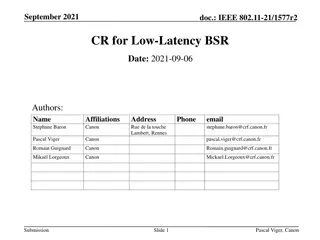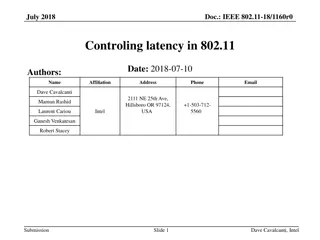Low Latency Resource Agreements in IEEE 802.11-20 for Better Channel Access
Proposal suggests enabling agreements between nodes with different traffic requirements to share resources during reserved TXOP, ensuring more predictable channel access and lower latency for critical transmissions in IEEE 802.11-20 networks.
Download Presentation

Please find below an Image/Link to download the presentation.
The content on the website is provided AS IS for your information and personal use only. It may not be sold, licensed, or shared on other websites without obtaining consent from the author.If you encounter any issues during the download, it is possible that the publisher has removed the file from their server.
You are allowed to download the files provided on this website for personal or commercial use, subject to the condition that they are used lawfully. All files are the property of their respective owners.
The content on the website is provided AS IS for your information and personal use only. It may not be sold, licensed, or shared on other websites without obtaining consent from the author.
E N D
Presentation Transcript
October 2020 doc.: IEEE 802.11-20/1670r1 Low Latency resource agreements Date: 2020-10-19 Authors: Name Jonas Sedin Affiliations Ericsson Address Torshamnsgatan 23, Kista, Sweden Phone email Jonas.sedin@ericsson.com Rocco Di Taranto Charlie Pettersson Leif Wilhelmsson Submission Jonas Sedin, Ericsson Slide 1
October 2020 doc.: IEEE 802.11-20/1670r1 Abstract The TXOP mechanism and/or long transmit durations are well suited to non-critical transmissions, however critical transmissions suffer from the channel access delay induced by it Methods are needed to provide more predictable channel access when STAs with different set of traffic requirements can coexist better We propose to enable agreements between two nodes with different traffic requirements to allow sharing of resources during a reserved TXOP Thus no need pre-configure any BSS-specific resources for low latency transmissions Submission Jonas Sedin, Ericsson Slide 2
October 2020 doc.: IEEE 802.11-20/1670r1 Background Low latency is an important feature that has been discussed within 11be: [1] presents a set of proposals one of them being RD protocol for STA to AP and between OBSS STAs [2] presents an approach to enable periods of time during which low latency traffic can be protected from intra- BSS congestion [3] proposes a general channel access method and associated signaling to provide a more predictable/latency throughput performance [4] discusses possible ways for AP to constrain the use of protected channel access by using restricted TWT SPs [5] reservation of resources for specific traffic announced by beacon or probe response A lot of the proposals require changes at the MAC layer and may still not be able to guarantee bounded latency or channel access We propose simple solutions to establish agreements between devices to guarantee more bounded channel access latency Submission Jonas Sedin, Ericsson Slide 3
October 2020 doc.: IEEE 802.11-20/1670r1 Problem: Critical transmissions and TXOP mechanism Non-critical traffic: Any type of traffic without strict priority and reliability requirements Critical traffic: May arrive at any time with high priority requirements. In this example, AP2 will suffer severely from not being able to share resources from AP1 and AP1 will still have to contend with AP2 Submission Jonas Sedin, Ericsson Slide 4
October 2020 doc.: IEEE 802.11-20/1670r1 Problem: Critical transmissions and TXOP mechanism As an example simulation: A single AP A STA with a non-critical full buffer traffic model, using 4ms TXOP limit A STA with low latency small packet data arriving from higher layers roughly every 0.05s It can be seen that the STA with low latency will not only suffer from large average latency, but also from a long tail While the example is simple, it highlights a major issue For critical traffic, improving the latency of the large tail is just as important as improving average latency Submission Jonas Sedin, Ericsson Slide 5
October 2020 doc.: IEEE 802.11-20/1670r1 Example: Critical Transmissions Time Duration If a STA wants to transmit 115 Bytes of critical data along with an ACK, it would take the following amount of time with 20MHz BW HE, 242 carriers Preamble + header + MPDU(MCS3): 44us + 13.6us + 3*13.6us = 106.4us SIFS: 16us Ack: Preamble + header: 44us + 13.6us = 57.6us This sums up to 180us, which compared to maximum TXOP duration of 4.096ms, equals to a 3% of its duration Clearly letting a critical short transmission wait for the whole TXOP duration before contending for the channel is not a preferable solution Submission Jonas Sedin, Ericsson Slide 6
October 2020 doc.: IEEE 802.11-20/1670r1 Proposal The basic idea: Enable the AP/non-AP STAs to share or partially share their TXOPs with other AP/non-AP STAs through pre-configured agreement between two AP/non-AP STAs Agreement is only between two nodes and thus legacy devices will not be affected The amount of reserved resources is set during the negotiation phase; however critical transmissions generally have small data packets and need small fractions of the TXOP length. Submission Jonas Sedin, Ericsson Slide 7
October 2020 doc.: IEEE 802.11-20/1670r1 Proposal 1: Opportunistic spatial reuse agreements One way to enable a STA to send critical data that may arrive during an ongoing TXOP transmission of another STA is to let the critical transmission overlap with the ongoing transmission(s) The agreement between the two STAs may allow them to transmit on certain resources or for the whole TXOP duration whenever they reserve a TXOP. A special case of the pre-emption is when both transmissions go through and/or if any of the nodes lower their transmission power this moves it close to spatial reuse Submission Jonas Sedin, Ericsson Slide 8
Month Year doc.: IEEE 802.11-20/1670r1 Proposal 2: Low latency resources in TXOP agreements Another way to enable a STA to send critical data that may arrive during an ongoing TXOP transmission of another STA is to leave out empty resources within the TXOP An agreement is thus made whereby the TXOP owner will not transmit on some resources and allow the other STA to transmit on those resources Submission Jonas Sedin, Ericsson Slide 9
October 2020 doc.: IEEE 802.11-20/1670r1 Proposal 2 cont: Low latency resources in TXOP agreements The resources reserved for critical transmissions may be reclaimed by the TXOP owner (e.g., if not used) or released by the STA with critical data (e.g., if not needed or used). Reclaiming the resources may be required to deal with channel access rules If the STA is required to send an indication whenever the resources are not needed, then it would be beneficial for the STA to end the agreement which prevents the resources from being wasted Submission Jonas Sedin, Ericsson Slide 10
October 2020 doc.: IEEE 802.11-20/1670r1 Advantages By allowing sharing of resources, the latency for critical data is not only expected to be reduced but also bounded In proposal 1 the channel access delay may be very low but cause interference, while in proposal 2 the channel access delay would be higher but with no interference The loss in throughput is expected to be minimal for the device that shares The proposed solution can co-exist with legacy devices as the nodes only use each other s resources This opposed is to other proposed methods where empty resources are reserved in time for latency critical access that legacy devices would not understand Submission Jonas Sedin, Ericsson Slide 11
October 2020 doc.: IEEE 802.11-20/1670r1 Relation to previous work COT sharing In LAA/NR-U methods exists for a gNB to share its TXOP with its UE 11ax Spatial reuse It is not suitable for low latency uses due the ad-hoc nature of 11ax SP, where any STA may transmit if a Spatial Reuse frame is sent Reverse Direction protocol Reverse Direction protocol allows an AP to reserve a TXOP and grant a non-AP STA to transmit in our proposal the grant is not needed and the coordination may be intra-BSS Submission Jonas Sedin, Ericsson Slide 12
October 2020 doc.: IEEE 802.11-20/1670r1 Regulatory aspects EN 301.893 [6] allows for sharing of transmission resources between an initiating device and a responding device under certain conditions Otherwise access to the channel will have similar issues as in the currently discussed 11be feature Multi-AP Submission Jonas Sedin, Ericsson Slide 13
October 2020 doc.: IEEE 802.11-20/1670r1 Summary We have proposed two mechanisms to allow critical transmissions during ongoing transmissions in a reserved TXOP. The two mechanisms are based on Opportunistic spatial reuse agreements Low Latency resources in TXOP Submission Jonas Sedin, Ericsson Slide 14
October 2020 doc.: IEEE 802.11-20/1670r1 SP Do you agree that low latency could be achieved through pre-configured agreements between STAs? Submission Jonas Sedin, Ericsson Slide 15
October 2020 doc.: IEEE 802.11-20/1670r1 References [1] 11-20-0005r1 Proposals on Latency Reduction [2] 11-20-1350r0 Enhancements for QoS and low latency in 802.11beR1 [3] 11-20-1045r3 Prioritized EDCA Access [4] 11-20-1046r4 Proposed TWT Enhancement for Latency Sensitive Traffic [5] 11-20-1355r2 Access mechanisms to meet the requirements of low latency traffics [6] ETSI EN 301 893 5GHz RLAN Harmonised Standard covering the essential requirements of article 3.2 of Direction 2014/53/EU V2.0.7 (2016- 11) Submission Jonas Sedin, Ericsson Slide 16























